The story of the incomparable Bell and Howell Filmo 16mm movie camera (page 2)
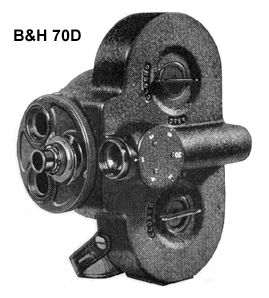 The model 70C was the first
Filmo to come factory-equipped with the three lens turret. B&H offered a
retrofit kit for earlier models to convert to the turret style for just a
few dollars. This unique feature was a first for a 16mm camera and allowed
the Filmo to cover any possible filming situation the photographer might
come up against. B&H sold all early Filmo's exclusively with English-made
Cooke lenses beginning with a 15MM F2.5 and extending all the way up to a
6" F5.5. The Cooke 1" F3.5 universal focus anastigmat was normally sold as
standard equipment but any lens in the series could be ordered with the camera.
Cooke lenses were renown for their extremely high definition and flatness
of field across the entire frame. The standard 1" threaded "C" mount was
used on all three ports making the camera compatible with literally hundreds
of possible lens combinations. By
The model 70C was the first
Filmo to come factory-equipped with the three lens turret. B&H offered a
retrofit kit for earlier models to convert to the turret style for just a
few dollars. This unique feature was a first for a 16mm camera and allowed
the Filmo to cover any possible filming situation the photographer might
come up against. B&H sold all early Filmo's exclusively with English-made
Cooke lenses beginning with a 15MM F2.5 and extending all the way up to a
6" F5.5. The Cooke 1" F3.5 universal focus anastigmat was normally sold as
standard equipment but any lens in the series could be ordered with the camera.
Cooke lenses were renown for their extremely high definition and flatness
of field across the entire frame. The standard 1" threaded "C" mount was
used on all three ports making the camera compatible with literally hundreds
of possible lens combinations. By 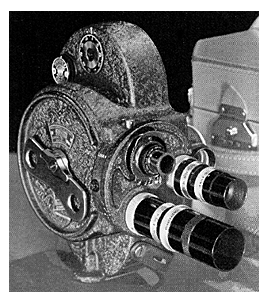 1930, with the introduction of the 70D,
all subsequent models, with the exception of the high speed versions, were
now equipped with seven filming speeds. Up until this point
you were limited
to the two speeds of 8 and 16fps or 16 and 32fps and, with the model 70AB the speeds of
12, 16 and 24fps. 16fps was considered normal speed. Anything above this
would have been "slow motion". The idea of using 8fps basically gave you
a 100% increase in exposure as long as what you were filming did not involve
movement of people or any fast action.
1930, with the introduction of the 70D,
all subsequent models, with the exception of the high speed versions, were
now equipped with seven filming speeds. Up until this point
you were limited
to the two speeds of 8 and 16fps or 16 and 32fps and, with the model 70AB the speeds of
12, 16 and 24fps. 16fps was considered normal speed. Anything above this
would have been "slow motion". The idea of using 8fps basically gave you
a 100% increase in exposure as long as what you were filming did not involve
movement of people or any fast action.
The camera was never equipped
with a reflex or through-the-lens viewfinder. Instead, it used three
versions of a side-finder arrangement. Beginning with the model 70D the Filmo
was equipped with what was called in the literature, a "revolving drum variable
angle spyglass" viewfinder (see photo of the 70D, above). A dial on the side
of the eyepiece allowed the operator to rotate one of six fields of view
into place depending on the focal length of the lens used. This was also
offered as a factory conversion for models 70A - 70C, but cameras had to
be sent back to the factory for a custom fitting. The later Filmos featured
a "positive-type separate objective" viewfinder. This looked like a miniature
version of the three lens turret. Each camera lens of a given focal length
had a matching focal length objective that, in later models, rotated
automatically into place through a gearing arrangement as you selected the
lens you were going to shoot with.
At the 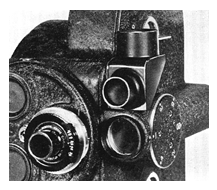 back
of the viewfinder was an adjustment for correcting parallax and to compensate
for the operators particular vision needs. A photographer would have to rely
on the markings on the lens to set distance quickly or use a technique common
to still photographers where they would set their lens to a given distance
and then move in on the subject until they reached that point. In addition,
something which was first offered on the 70DA, Bell & Howell provided
what they referred to as a "critical focuser" device. To use it the operator
would swing the taking lens around to the winding key side and then peer
into a tiny port at the edge of the turret. Although only a small portion
of the image in the center was actually visible this did allow one to actually
look through the lens and precisely adjust the focus.
back
of the viewfinder was an adjustment for correcting parallax and to compensate
for the operators particular vision needs. A photographer would have to rely
on the markings on the lens to set distance quickly or use a technique common
to still photographers where they would set their lens to a given distance
and then move in on the subject until they reached that point. In addition,
something which was first offered on the 70DA, Bell & Howell provided
what they referred to as a "critical focuser" device. To use it the operator
would swing the taking lens around to the winding key side and then peer
into a tiny port at the edge of the turret. Although only a small portion
of the image in the center was actually visible this did allow one to actually
look through the lens and precisely adjust the focus.
This could only be
used for static set ups where the action would wait for you. For shooting
closeup work or when photographing titles you could purchase a device called a
"focusing alignment gauge". Basically, it was a rack-over attachment that
mounted between the tripod and the camera. It allowed one to slide the camera
from the focusing position to the shooting position and still maintain the
correct image alignment. There was also something called a "waist level
viewfinder" (see photo) so you could shoot from the hip so to speak.
Actually, it was made for taking unusual or low angle shots. It mounted to
the film compartment door just above the existing viewfinder tube. The French
lens manufacturer, Angenieux, also released a zoom lens in the early 1960's
that was equipped with a side-finder. It made
through-the-lens
reflex viewing possible for 16mm cameras like the Filmo and others that were
never so equipped.
 In 1933, Bell & Howell
introduced several modifications in their model 70DA which they marketed
as the semi-professional Filmo. A removable 200' magazine was added
along with an electric motor option of either 12 or 110 volts. In addition,
a newly designed range finder, fitted to the film compartment door, made
it possible to determine subject distance accurately. B&H added the hand
crank option beginning with this model. The crank was fitted to a port just
below the winding key. The same port used for the electric drive. It allowed
the operator to hand crank the full 100 foot load if necessary to cover the
action. The speed was regulated by the internal governor as long as the operator
kept up with the cranking. Using the hand crank the camera could also be
backwound for producing lap dissolves and double exposures.
In 1933, Bell & Howell
introduced several modifications in their model 70DA which they marketed
as the semi-professional Filmo. A removable 200' magazine was added
along with an electric motor option of either 12 or 110 volts. In addition,
a newly designed range finder, fitted to the film compartment door, made
it possible to determine subject distance accurately. B&H added the hand
crank option beginning with this model. The crank was fitted to a port just
below the winding key. The same port used for the electric drive. It allowed
the operator to hand crank the full 100 foot load if necessary to cover the
action. The speed was regulated by the internal governor as long as the operator
kept up with the cranking. Using the hand crank the camera could also be
backwound for producing lap dissolves and double exposures.
Of all the features it
was the wide range of filming speeds available that made the camera a favorite
of professionals and serious amateurs alike. The speed was set by adjusting
a governor dial that, although it was marked off with seven of the most commonly
used speeds, had no click stops so the camera was able to run at any speed
between 8 and 48 frames per second. All the cameras accepted 50 or 100' internal
loads with the 70H, the 70F and the final version 70HR factory equipped for
an external 400' magazine option. At 204 degrees, the camera would seem to
have had a somewhat wider shutter than needed but when you consider the camera
was not limited to just shooting at 24fps (where a 175 to 180 degree shutter
would be the norm) the wider shutter width makes sense for the higher speeds.
In fact, the high speed model 70S had a 216 degree shutter to accommodate
the single running speed of 128 frames per second. 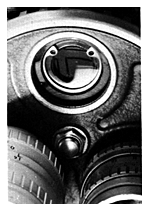
B&H also designed in
something they referred to as "shock absorbing sprockets".
By mounting the
supply and take up sprockets on tiny springs rather than directly attached
to their shafts, the film was protected from the sudden shock of movement
each time the camera release was pressed. This prevented tearing and nicking
of the film sprockets especially in cold weather when the film would be more
fragile and vulnerable to breakage. Some model Filmos, like the 70DR for
instance, had one of their lens ports modified with a behind the lens filter
holder (see photo). The gelatin filter was held in place just below the lens
seat by a small locking ring.
The Bell & Howell Filmo
may have had its biggest impact on the beginnings of television news. In
the mid to late 50's and early 60's when local stations first began to venture
out of the studio and incorporate film into their nightly news programs,
it was the well proven 16mm Filmo they chose to acquire B&W footage of
local events. Even after stations adopted more sophisticated magnetic sound-on-film cameras like the Auricon,
the Filmo remained
the workhorse "stringer" camera. Some of the most dramatic close combat footage
from the Vietnam war was shot by both NBC and CBS using Filmo's.
Still going strong, still a camera to be reckoned with...
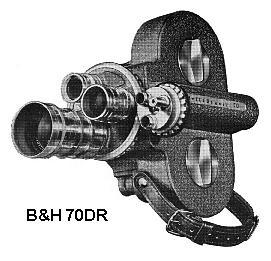 Today, the B&H Filmo
16mm camera has found renewed interest and respect among student and independent
filmmakers. The low cost of ownership and simple maintenance requirements
make the Filmo ideal for filmmakers just starting out. The camera is also
appreciated by seasoned veterans who need to capture material quickly and
easily without calling attention to themselves. Like the 35mm Eyemo, it is
the perfect crash camera. With a few simple tools it can be fashioned to
a bike, a boat, a car, to a skateboard, a wheelchair, a glider...you name
it. Clever souls can probably even connect a stepping motor to the crank
port and run the camera all day off a lead acid battery!
Today, the B&H Filmo
16mm camera has found renewed interest and respect among student and independent
filmmakers. The low cost of ownership and simple maintenance requirements
make the Filmo ideal for filmmakers just starting out. The camera is also
appreciated by seasoned veterans who need to capture material quickly and
easily without calling attention to themselves. Like the 35mm Eyemo, it is
the perfect crash camera. With a few simple tools it can be fashioned to
a bike, a boat, a car, to a skateboard, a wheelchair, a glider...you name
it. Clever souls can probably even connect a stepping motor to the crank
port and run the camera all day off a lead acid battery!
A basic package, like the
one shown in the color photo, consists of a late-model camera, light meter,
grey card, carry bag and some film. This 70DR, the last model made, is fitted
with an Angenieux 25mm F.95 lens. Although this lens does have a focus collar
it is much easier to use by relying on the principle of hyperfocal distance
when coupled with todays faster film stocks. Using a hyperfocal chart you
would set the lens focus at a point that would provide maximum depth of field
for a given F stop. For instance, a 25mm (1") lens shooting at F5.6 and set
to a distance of 14' will provide a correctly focused image from 7' to infinity.
That same lens at F8 and set to 10' would be good from 5' to infinity.
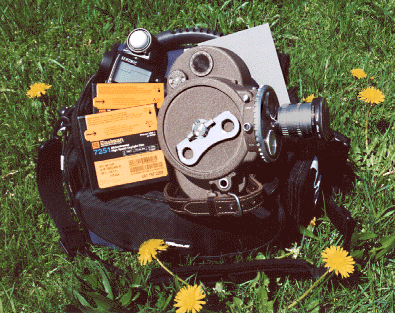 Of course, what makes owning
a camera like the classic 16mm Filmo or the 35mm Eyemo so intriguing these
days is you get to use the best film stocks Kodak and Fuji have ever made
inside them. Painstaking old-time camera craftsmanship now married with the
most up to date scientific and chemical breakthroughs in film technology.
Truly the best of both worlds. Many a cleverly conceived TV commercial or
public service announcement that was destined for a video shoot could have
been made that much more effective through the use of film in a camera like
the Filmo... and for next to nothing. A spot that would have been remembered.
Of course, what makes owning
a camera like the classic 16mm Filmo or the 35mm Eyemo so intriguing these
days is you get to use the best film stocks Kodak and Fuji have ever made
inside them. Painstaking old-time camera craftsmanship now married with the
most up to date scientific and chemical breakthroughs in film technology.
Truly the best of both worlds. Many a cleverly conceived TV commercial or
public service announcement that was destined for a video shoot could have
been made that much more effective through the use of film in a camera like
the Filmo... and for next to nothing. A spot that would have been remembered.
When looking for a good,
used Filmo try to look for later models like the 70DE, 70DL, 70DR and 70HR
if you need a camera with the most sought after features discussed here.
These cameras, unlike many of the earlier models, will accept single-sprocketed
film, which is sometimes easier to come by if you purchase short ends or
recans and want to spool your own stock. IMHO the 16mm Bell & Howell
Filmo is a camera that can make filmmaking fun again. It's that simple.
Summer's coming... do you have yours yet?

Copyright © 2018, TFG Transfer | All Rights Reserved
The Bell and Howell Filmo 16mm movie camera, B&H, Bell and Howell 16mm Filmo, the filmo camera, 16mm color b&w motion picture film, filmmaking, newsreels, movie making on a budget, how to make a movie, software for movie making, the ultimate moviemaking guide, how to make a movie for beginners, dlp lcd video projectors, student filmmakers guide to making a movie, shooting digital video, used camera lenses for sale, where to rent 35mm camera lenses, digltal cinema movie camera, selling cameras, jobs in television news, combat newsreel cameraman, film jobs, tv jobs, schools that teach filmmaking, become a photojournalist, war correspondent, perfect crash camera, buy 16mm camera lenses, combat newsreel photographer, 16mm footage of the war, high resolution video projectors